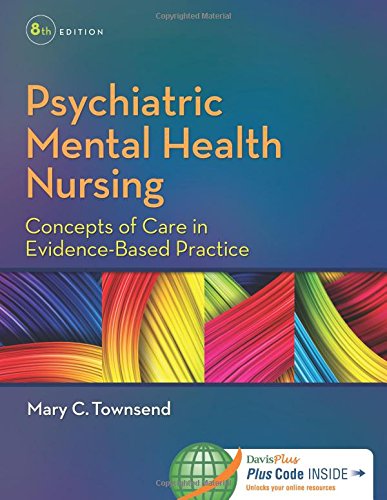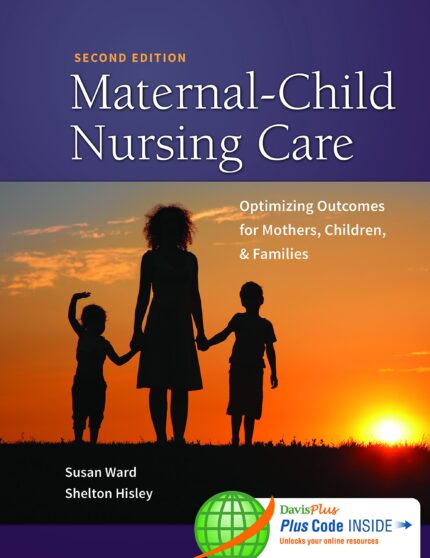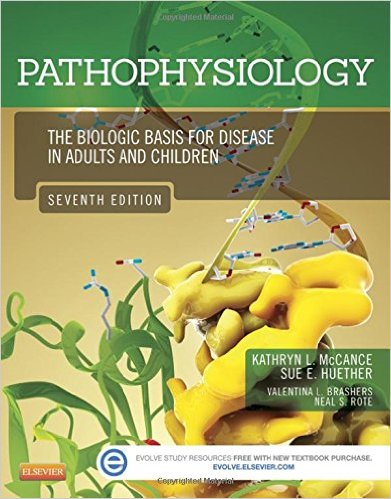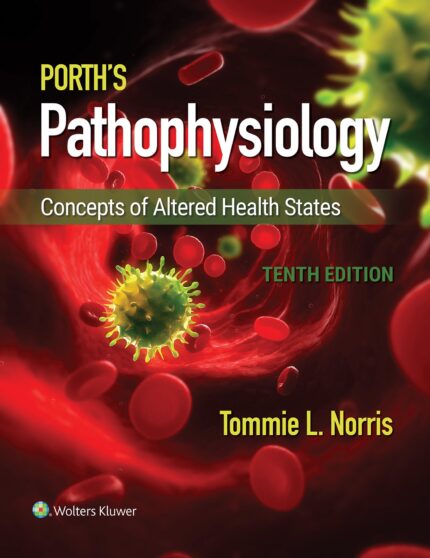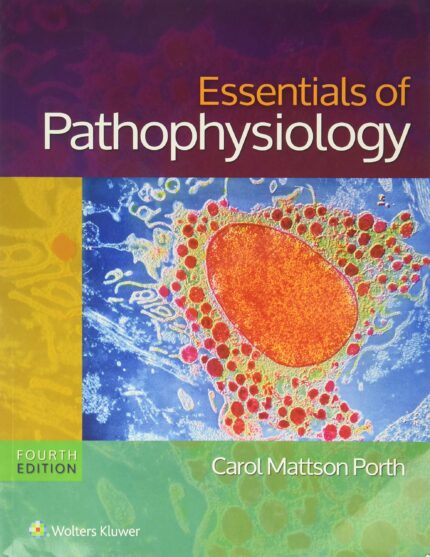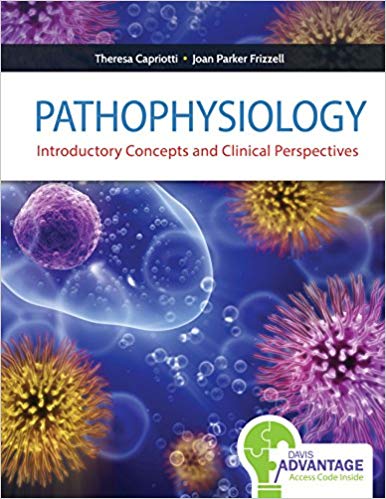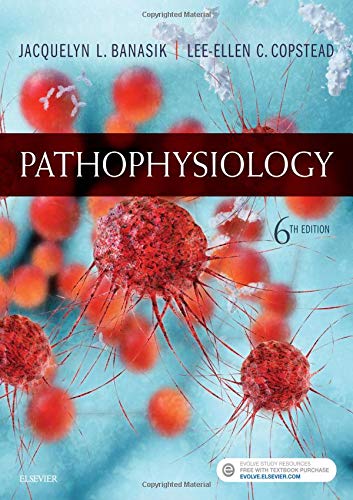Test Bank for Pathophysiology Introductory Concepts and Clinical Perspectives by Capriotti
Chapter 1: The Cell in Health and Illness
Multiple Choice
Identify the choice that best completes the statement or answers the question.
____ 1. Which statement regarding the sodium-potassium pump is correct?
| 1. | The cell’s plasma membrane is more soluble to sodium ions than potassium ions. |
| 2. | The concentration of sodium ions should be higher inside the cell compartment. |
| 3. | The concentration of potassium ions should be higher outside the cell compartment. |
| 4. | The active transport involves pumping out three sodium ions and pumping in two potassium ions. |
____ 2. What is the process in which glucose is used to create energy?
| 1. | Autolysis |
| 2. | Glycolysis |
| 3. | Heterolysis |
| 4. | None of the above |
____ 3. How many adenosine triphosphates (ATPs) are produced in aerobic energy metabolism?
| 1. | 2 |
| 2. | 3 |
| 3. | 34 |
| 4. | None of the above |
____ 4. Which cell organelles are believed to have once been self-sustaining and independent?
| 1. | Ribosomes |
| 2. | Mitochondria |
| 3. | Ribonucleic acid |
| 4. | Deoxyribonucleic acid |
____ 5. Why is more energy produced when a person is exercising?
| 1. | There is an increase in the synthesis of protein. |
| 2. | There is an increase in the production of pyruvic acid in the cells. |
| 3. | There is an increase in the conversion of pyruvic acid to lactic acid. |
| 4. | There is an increase in the production of mitochondria in the muscle cells. |
____ 6. When does ribosomal protein synthesis cease?
| 1. | During endoplasmic reticulum (ER) stress |
| 2. | During the synthesis of ATP |
| 3. | During severe hypoxic state |
| 4. | During the processing of prohormone |
____ 7. The cellular organelle responsible for propelling mucous and inhaled debris out of the lungs is
| 1. | cilia. |
| 2. | microfilament. |
| 3. | secretory vesicle. |
| 4. | endoplasmic reticulum. |
____ 8. Which are the key proteins in the contractile units of the muscle cells?
| 1. | Actin and myosin |
| 2. | Myosin and tubulin |
| 3. | Tubulin and actin |
| 4. | None of the above |
____ 9. Which deficiency causes Tay-Sach’s disease?
| 1. | Proteasome |
| 2. | Peroxisome |
| 3. | Macrophage |
| 4. | Lysosomal enzymes |
____ 10. Adrenoleukodystrophy is characterized by
| 1. | Accumulation of ganglioside. |
| 2. | Cessation of ribosomal protein synthesis. |
| 3. | Acceleration of cellular proteasome activity. |
| 4. | Accumulation of long chain fatty acid s in the nervous system. |
____ 11. Which statement regarding endoplasmic reticulum (ER) stress is correct?
| 1. | During ER stress, proteins are rapidly degraded. |
| 2. | During ER stress, lipids cannot travel to their proper intracellular locations. |
| 3. | During ER stress, accumulation of long chain fatty acids occurs in the nervous system. |
| 4. | During ER stress, accumulation of non-degraded substances occurs in the cells. |
____ 12. Which is referred to as the protein factory of the cell?
| 1. | Ribosome |
| 2. | Mitochondria |
| 3. | Golgi apparatus |
| 4. | Endoplasmic reticulum |
____ 13. Which acts as a blue print for the construction of proteins?
| 1. | Transfer RNA |
| 2. | Ribosomal RNA |
| 3. | Messenger RNA |
| 4. | Mitochondrial DNA |
____ 14. A hiker experiences muscle pain and acidosis as he or she ascends a mountain during a long, steep climb. What is the reason for these symptoms?
| 1. | Cellular hypoxia |
| 2. | Autolysis |
| 3. | Heterolysis |
| 4. | Cellular edema |
____ 15. Which factor provides DNA the unique molecular ability to replicate?
| 1. | The precise pairing of the nitrogenous bases |
| 2. | The presence of pyrimidines bases |
| 3. | The presence of nucleotides |
| 4. | The nitrogenous base and phosphate bond |
____ 16. How many nitrogenous bases compose a single codon?
| 1. | 2 |
| 2. | 3 |
| 3. | 4 |
| 4. | None of the above |
____ 17. The DNA is a polymer of
| 1. | Nucleotides. |
| 2. | Amino acids. |
| 3. | Fatty acids. |
| 4. | Phosphates. |
____ 18. What is the function of ribosomal ribonucleic acid during protein synthesis?
| 1. | It transports genetic information from the DNA for protein synthesis. |
| 2. | It gathers and joins the amino acids for specific proteins. |
| 3. | It is directly involved in the formation of ribosomes. |
| 4. | None of the above. |
____ 19. Tetracycline antibiotic was given to a 30 year old client with Chlamydia infection. What is the mechanism of action of the drug?
| 1. | It prevents the replication of bacteria. |
| 2. | It alters the configuration of bacterial cytoplasm. |
| 3. | It interferes with the function of bacterial ribosomes. |
| 4. | It inhibits the functions of bacterial mitochondria. |
____ 20. Where does the conversion of a prohormone into a hormone take place?
| 1. | Ribosome |
| 2. | Golgi apparatus |
| 3. | Secretory granule |
| 4. | Endoplasmic reticulum |
____ 21. Which is the cell’s “master mind”?
| 1. | Nucleus |
| 2. | Ribosome |
| 3. | Golgi apparatus |
| 4. | Endoplasmic reticulum |
Multiple Response
Identify one or more choices that best complete the statement or answer the question.
____ 22. Which statements regarding the microtubules are true? Select all that apply.
| 1. | Microtubules are solid. |
| 2. | Microtubules are flexible. |
| 3. | Microtubules are composed of tubulin. |
| 4. | Microtubules are called actin filaments. |
| 5. | Microtubules comprise of centrioles and mitotic spindle. |
____ 23. Which structures are found in microtubules? Select all that apply.
| 1. | Cilia |
| 2. | Centrioles |
| 3. | Mitotic spindle |
| 4. | Actin filaments |
| 5. | Secretory vesicles |
____ 24. What are the characteristics of ribonucleic acid? Select all that apply.
| 1. | Presence of ribose pentose sugar |
| 2. | Presence of single stranded helix |
| 3. | Presence of double stranded helix |
| 4. | Presence of deoxyribose pentose sugar |
| 5. | Presence of uracil and cytosine as pyrimidine base |
____ 25. Which are the purine bases found in deoxyribonucleic acid and ribonucleic acid? Select all that apply.
| 1. | Uracil |
| 2. | Adenine |
| 3. | Guanine |
| 4. | Thymine |
| 5. | Cytosine |


